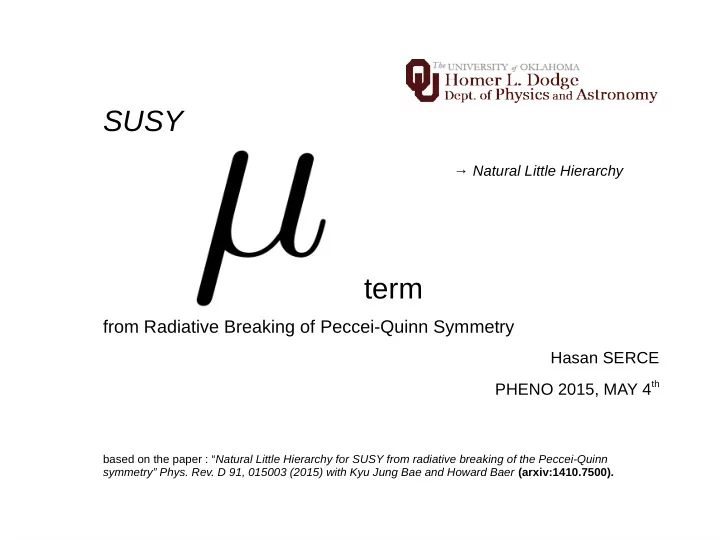

SUSY → Natural Little Hierarchy term from Radiative Breaking of Peccei-Quinn Symmetry Hasan SERCE PHENO 2015, MAY 4 th based on the paper : “ Natural Little Hierarchy for SUSY from radiative breaking of the Peccei-Quinn symmetry” Phys. Rev. D 91, 015003 (2015) with Kyu Jung Bae and Howard Baer (arxiv:1410.7500) .
Standard Model and beyond m h ~ 125 GeV → SM ✔ & SUSY ... but no sign of SUSY at the LHC (yet). m sparticles ≥ TeV where m sparticles ∼ m 3/2 (in gravity mediation) 2 ~ m hidden / M P In spite of large m h and LHC sparticle limits, SUSY can still be natural: → m 2 Hu driven to ~ ( – m 2 Z ) → μ ~100-200 GeV and m sparticles ∼ TeV apparent Little Hierarchy: μ << m 3/2 ~ multi-TeV (LHC bounds)
SUSY μ Problem M P the problem: ● μ is supersymmetric so one expects it to be at the order of Planck scale → μ ~ M P But phenomenology ( m 2 Z ~ – 2 μ – 2 m 2 Hu ) requires μ ~ 100-200 GeV. the solution: ● Step 1: Forbid μ via some symmetry. Step 2: Regenerate μ via coupling to some field which acquires a vev under some symmetry breaking. μ
Solutions to μ Problem: 1. NMSSM superfield, S develops vev <S> ~ m 3/2 → μ ~ λ S m 3/2 problem with gauge singlets (see Supersymmetry Primer by S.P. Martin). 2. Guidice-Masiero Some (unknown) symmetry forbids μ but Higgs doublets coupled to a hidden sector field, h : field h develops vev <h> ~ m 2 hidden where m 2 hidden is hidden sector mass parameter with m 2 hidden ~ m 3/2 × M Pl → μ ~ λ m 3/2 3. Kim-Nilles (SUSY DFSZ) PQ symmetry forbids μ but Higgs doublets carry PQ charges and coupled to a PQ charged superfield P : W DFSZ = λ H (P 2 /M P ) H u H d , W PQ = λ S S(PQ- ν 2 PQ /2) H u H d under PQ symmetry breaking P and Q receives a vev ~ ν PQ / √ 2 → μ = λ H ν 2 PQ /2M P
MSY Model H. Murayama, H. Suzuki and T. Yanagida Phys.Lett. B291 (1992) 418-425 → a DFSZ-like SUSY axion model with radiatively broken PQ Symmetry. augment MSSM superpotential with PQ charged fields X, Y : the relevant part of scalar potential is: (very flat) corresponding soft SUSY breaking terms are given by : minimize V at a scale Q = ν PQ to find vevs of Φ X and Φ Y Phys. Rev. D 91, 015003 (2015) (K.J.Bae,H.Baer,H. Serce )
Breaking Symmetry Radiatively Breaking PQ Symmetry (MSY) EW Symmetry Breaking
Breaking PQ Symmetry (MSY) The potential has 2 minima on ν X - ν Y plane symmetrically located with respect to origin. Majorana neutrino mass term and SUSY μ term generated upon symmetry breaking: what to expect for the scale of g ? → unity: g ~ 1 for m 3/2 ~ TeV and μ ~100-200 GeV as required by naturalness so that Little Hierarchy μ << m 3/2 emerges from MSY. Phys. Rev. D 91, 015003 (2015) (K.J.Bae,H.Baer,H. Serce )
h i vs m 3/2 Plane 2 ) → 3.7 × 10 10 ≤ f a ≤ 1.1 × 10 11 f a = √ ( ν x 2 + 9 ν y 2 ) → 3.4 × 10 10 ≤ ν PQ ≤ 9.4 × 10 10 ν PQ = √ ( ν x 2 + ν y 10-11 GeV M N ~ 10 - Since f a determines axion mass, m a related to higgsino mass ! - Large values of g > 1 are required for rather low values of m 3/2 ~ 2 TeV. - For higher values of m 3/2 ≥ 5 TeV as favored by gravitino problem, then typically g ~ 0.5 is required to generate the Little Hierarchy.
Axion Search - ADMX II ADMX-II 2016 reach: m a ~ 40 μeV 1 Open resonator technique expected sensitivity: m a ~ 700 μeV 2 1 Status of the Axion Dark Matter Experiment (ADMX) L. Rosenberg Talk at the Patras Workshop at CERN (2014) 2 Phys. Rev. D. 91, 011701(R) (2015) (G.Rybka, A.Wagner, K.Patel, R.Percival, K.Ramos)
DM from EW and QCD Naturalness axion-higgsino mixture ! Coupled Boltmann computation of mixed axion-WIMP DM in SUSY DFSZ model with RNS benchmark point by keeping track of energy density and number densities of neutralinos, gravitinos, saxions, axinos, axions and radiation. → mainly axion CDM (~ 90%), 10% higgsino-like WIMPS unless f a ≥ 10 13 -10 14 GeV → large f a ≥ 10 14 GeV too much WIMP DM from saxion oscillation / decay JCAP 1410 (2014) 10, 082 ( arxiv:1406.4138 ) (K.J.Bae,H.Baer,A.Lessa,H. Serce )
Conclusions Given multi TeV values of m 3/2 , a class of models typified by MSY give rise to ● radiatively-driven PQ symmetry breaking and generates a weak scale value of μ (~100-200 GeV) and produces intermediate scale Majorana masses for right-hand neutrinos Little Hierarchy characterized by μ << m 3/2 emerges quite naturally and is indeed a ● feature expected from naturalness and LHC bounds. μ << m 3/2 is a consequence of ν PQ << m hidden . ● SUSY DFSZ/MSY axion model solves Big Hierarchy, strong CP and μ problem and ● Little Hierarchy (EW naturalness μ ~ m Z ) hence we get mixed axion-higgsino dark matter.
Recommend
More recommend